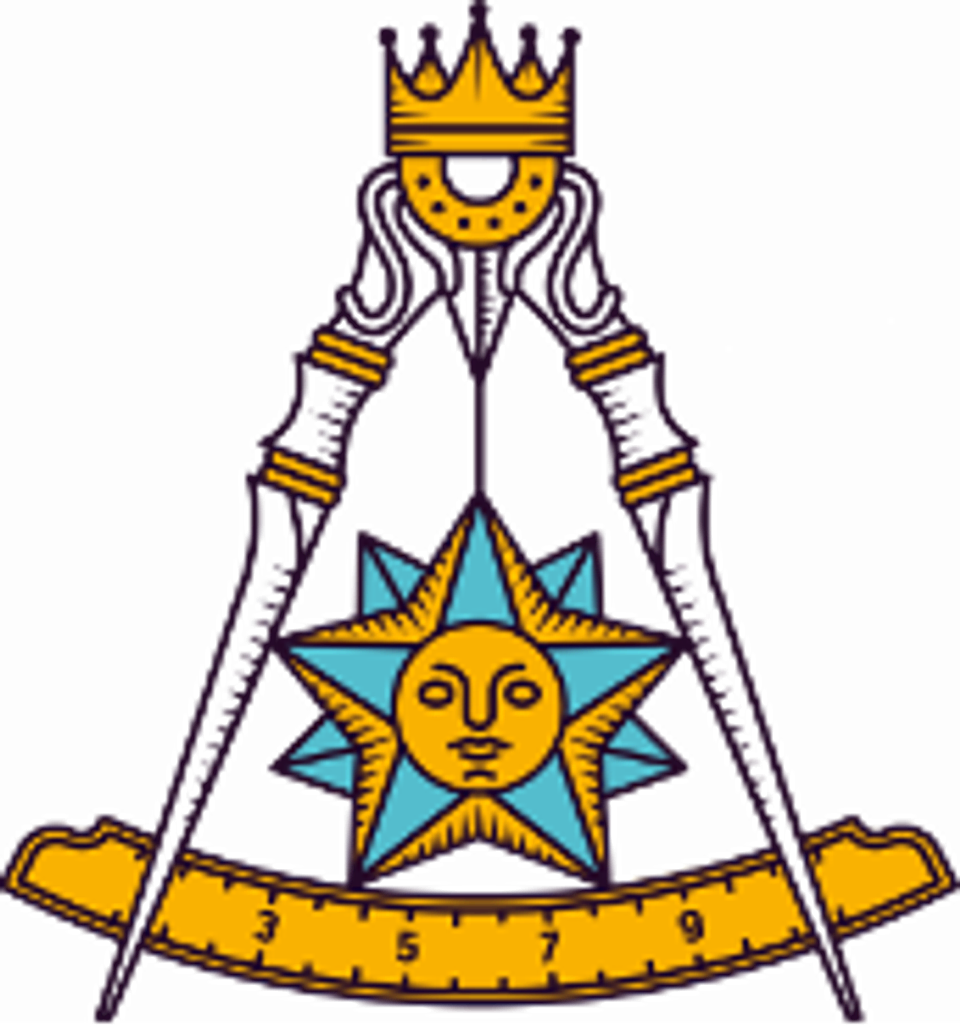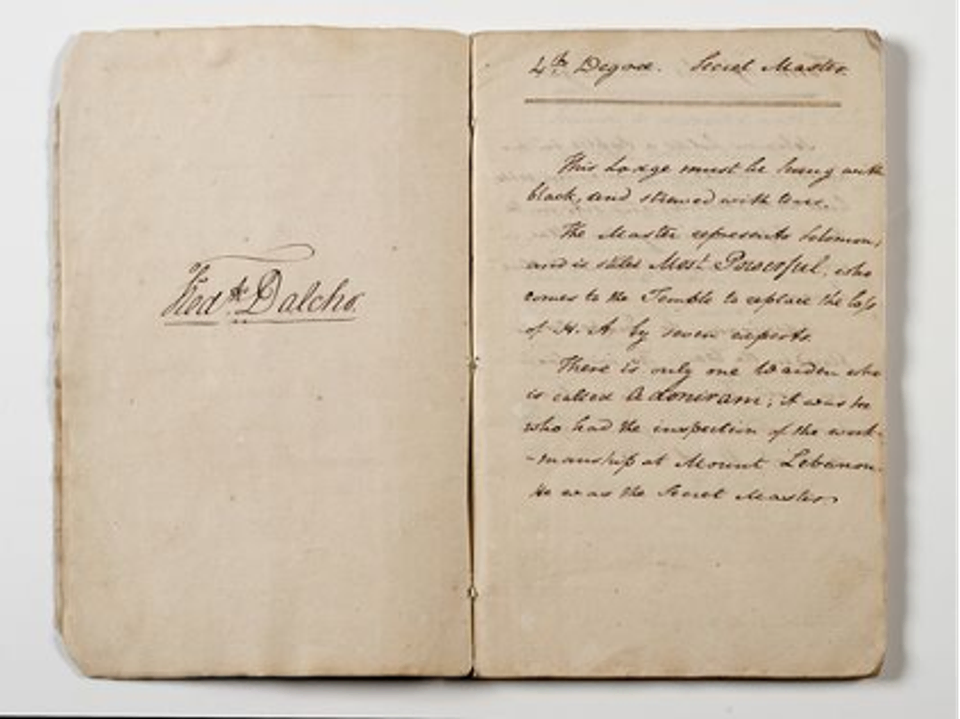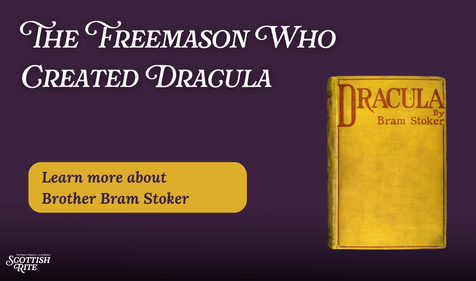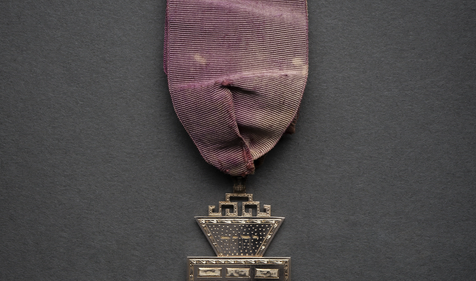This article explores the history of the Lodge of Perfection and its role in Scottish Rite Freemasonry.
Becoming a 32° Scottish Rite Freemason requires undertaking a journey further into the foundational principles of Freemasonry. The Scottish Rite expands upon the fundamental principles of Freemasonry through 29 additional degrees, exploring Masonic teachings more deeply. When a Master Mason first embarks on his journey in the Scottish Rite, he first encounters the "ineffable" degrees in the Lodge of Perfection, the body conferring the 4th through the 14th degrees.

The Lodge of Perfection Emblem
These eleven degrees investigate spirituality, focusing on the unutterable name of God and frequently referencing the three symbolic degrees of the Blue Lodge and applying them to everyday situations. Despite being the introduction to Scottish Rite Masonry, these degrees are anything but mundane. As with any Masonic degree, it takes years of revisiting and deliberate contemplation to grasp the lessons and significance of these degrees.
It is worth a step back through history to understand how the Lodge of Perfection earned its place in 32° Scottish Rite Freemasonry. From there, we can examine the degrees and their teachings.
The Lodge of Perfection in early Scottish Rite Freemasonry
The Scottish Rite began in Paris, France, around 1758 and was soon brought to North America by Henry Francken. In Albany, New York, the Ineffable Lodge of Perfection was chartered and constituted on December 26, 1767, nearly 50 years before the Scottish Rite, NMJ, was born. This body was the first Rite of Perfection on the American continent, which initially offered the 4th through 25th degree.
Over the next few decades, several Lodges of Perfection were created, including in Philadelphia and Charleston. These local groups were among the earliest to confer higher degrees in the United States, they were localized, and all three actively existed for relatively short periods, with none lasting into the 19th century except for the Lodge of Perfection in Albany, which was revived in the 1820s and is still around today.
As American Freemasonry matured in the early 1800s, the Scottish and York Rites began taking shape. On May 31, 1801, The Scottish Rite formalized its existence within the United States in 1801 when Colonel John Mitchell and Reverend Dr. Frederick Dalcho met in Charleston, South Carolina, and opened a meeting of the "Supreme Council 33° of Freemasonry." Today, thanks to the preservation efforts by the Scottish Rite Masonic Museum & Library, Dalcho's 1801 version of the 4th degree can be seen by interested Masons. It remains the closest we can get today to the first degree a candidate would have encountered upon his entrance into the Scottish Rite during its earliest days.
 Frederick Dalcho's 1801 version of the 4th degree, Secret Master. Courtesy of the Scottish Rite Museum & Library.
Frederick Dalcho's 1801 version of the 4th degree, Secret Master. Courtesy of the Scottish Rite Museum & Library.
Twelve years later, The Northern Masonic Jurisdiction was formed in New York City by a certificate granted by the Supreme Council of the now Southern Jurisdiction in August 1813. At that time, the organization of the higher degrees of Freemasonry in the United States was in disarray. Higher bodies competed for authority over degrees that lacked uniformity, creating confusion and animosity between groups until the Morgan Affair and Anti-Masonic Movement dealt a blow to Freemasonry in 1826.
Expansion, Unification, and the Consolidation of Subordinate Bodies
Despite the dramatic slowing of Masonic activity in America during this period, Grand Secretary General J.J.J. Gourgas kept the Northern Masonic Jurisdiction quietly operational. Gourgas maintained records and correspondence and even effected a territorial agreement with the Southern Jurisdiction in 1827 regarding the Northern Masonic Jurisdiction's sovereignty over the then 14 states situated east of the Mississippi and north of the Mason-Dixon Line.
Three years after Gourgas resumed the active business of the Supreme Council in 1843, the Supreme Council (NMJ) established the Supreme Council for England & Wales. The Brotherhood grew substantially and smoothly until the meeting of the Supreme Council in August 1860. While the actual events remain a subject of debate, a controversy among council members caused the body to split, with one group extensively changing the laws, statutes, and regulations of the Scottish Rite, Northern Masonic Jurisdiction.
The two groups came back together in 1867, intending to prioritize the consolidation of all subordinate bodies. During this time, the Lodge of Perfection was responsible for the largest percentage of Scottish Rite members in the NMJ. Entering a time of tremendous fraternal growth, the Scottish Rite, NMJ successfully adopted a unifying constitution, consolidating its bodies and establishing bodies in Vermont and Delaware, where it previously had no presence. In the 150 years since, the Lodge of Perfection has enjoyed its position as the entry point for new Scottish Rite Masons into the Brotherhood.
The Lodge of Perfection Today
The name of the Lodge of Perfection refers to the belief of Scottish Rite Masons that while they know they are not perfect, there is a path to perfection. Based upon legends from the era of King Solomon and Old Testament scripture, one of the key moral teachings in this body is that men must persevere and overcome difficulties in their progress toward perfection.
The Northern Masonic Jurisdiction has long prioritized revising its degree rituals. In some cases, rituals have been altered to make them easier for Valleys to perform, while other changes have been made to reflect modern thinking and meet contemporary Freemasons' needs. For example, a number of Consistory degrees were moved to replace existing ritual degrees in the 1970s. Most recently, a video version of the 4° was created to allow initiates to receive this degree in a more convenient, inspirational, and enjoyable way. A Brother becomes a Scottish Rite Mason once he has witnessed the 4°, an opportunity made available to Brothers by viewing the recorded version during a Rite on the Road or virtual Supreme Council event, such as a Join the Rite Night, or as presented in-person by a Valley’s degree cast.
As with any Masonic ritual, the degrees included in the Lodge of Perfection require extensive reflection, study, and revisiting. Here are brief summaries of the ethical teachings found in the Ineffable Degrees of this subordinate body:
4th Degree – Builder:
A Master Mason seeks divine guidance. Philosophy: Brothers grow together in Scottish Rite. Core Values: Reverence for God, Integrity, & Service to Humanity
5th Degree – Perfect Master:
Two sons of Aaron, corrupted by greed and ambition, allow the sacred flame to extinguish. Philosophy: Trustworthiness is more valuable than life and is the basis for Masonic honor. Core Values: Reverence for God, Justice & Integrity
6th Degree - Master of the Brazen Serpent:
When the children of Israel encounter a rough and dangerous journey through the desert, they rebel against Moses and God. Philosophy: The answer to the spiritual problems of humanity is faith in ourselves and God. Core Values: Reverence for God
7th Degree - Provost and Judge:
A dispute among the workers where honesty and justice prevail. Philosophy: We should render justice to all mankind. Core Values: Justice & Integrity
8th Degree - Intendent of the Building:
Based on the Old Testament story of King David and his assignment to his son, the future King Solomon. Philosophy: The degree reminds us that each honor we receive requires attention to a particular duty. Core Values: Service to Humanity, Integrity, & Reverence for God
9th Degree - Master of the Temple:
The Temple of King Solomon is dedicated by priests of many religions. Philosophy: We should not be too zealous in executing justice. Core Values: Reverence for God & Service to Humanity
10th Degree - Master Elect:
King Solomon learns of his sentence from which there is no appeal. Philosophy: The violator of his obligations to God will not go unpunished. Core Values: Reverence for God & Justice
11th Degree - Sublime Master Elected:
King Solomon's tax collector violates the public trust. Philosophy: When confronted by corrupt, unjust, or illegal behavior on the part of a person in authority, the nation should remain loyal and courageous. Core Values: Integrity
12th Degree - Master of Mercy:
Joseph forgives his brothers for selling him into slavery. Philosophy: We learn forgiveness, compassion, and Brotherly love. Core Values: Justice & Integrity
13th Degree - Master of the Ninth Arch:
The degree dramatizes the dangers encountered as men search for the lost word. Philosophy: We are reminded that difficulties and dangers should not deter us from pursuing moral perfection. Core Values: Reverence for God
14th Degree - Grand Elect Mason:
The essence of Symbolic Masonry is compiled in lessons of the Lodge of Perfection. Philosophy: Members are encouraged to worship God at the altar of their choice. Core Values: Reverence for God
These 11 degrees teach essential practical lessons that relate to our Core Values:
- Secrecy and silence in all confidential relationships
- Reverence and obedience to God
- Faithfulness to family and country
- Justice tempered by mercy
- Universal Brotherhood
- Honesty in business relations
- Forgiveness of past injustices
- Perseverance in overcoming the difficulties encountered in our progress toward perfection
In 32° Scottish Rite Freemasonry, we seek to strengthen our community and believe members should follow their judgment and the dictates of their conscience through life. Through the lessons found in the Lodge of Perfection and beyond, we strive to help good men become even better during their Masonic journey.
Related Stories
Discover additional Scottish Rite blogs and news on this topic.
-
The Freemason Who Created Dracula: The Story of Bram Stoker
History
Read More about The Freemason Who Created Dracula: The Story of Bram Stoker
-
A Funny Remembrance: The Life of Illustrious Brother Red Skelton, 33°
History
Read More about A Funny Remembrance: The Life of Illustrious Brother Red Skelton, 33°
-
A Past Grand High Priest Jewel Made for Albert Gallatin Mackey
History
Read More about A Past Grand High Priest Jewel Made for Albert Gallatin Mackey



